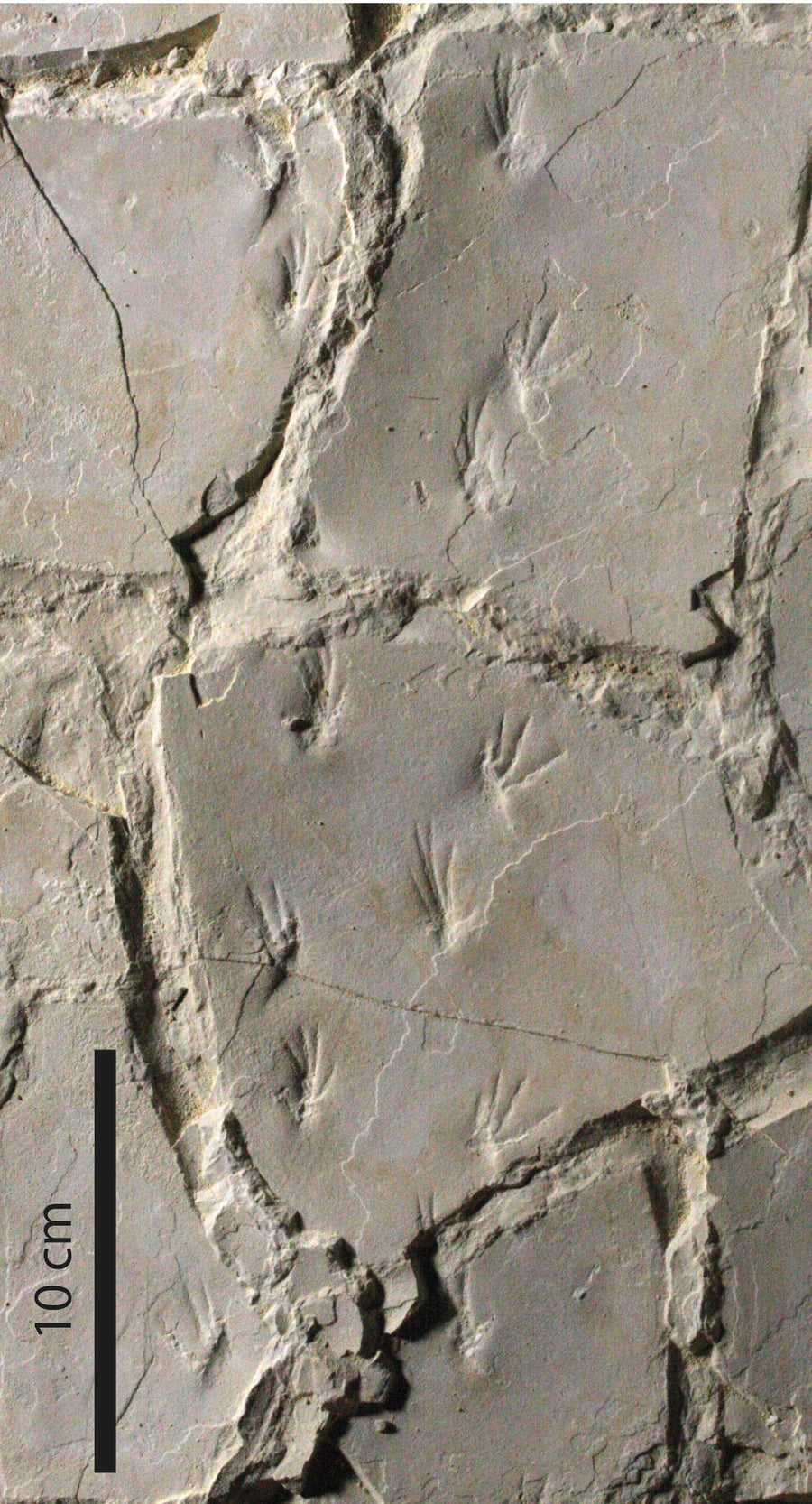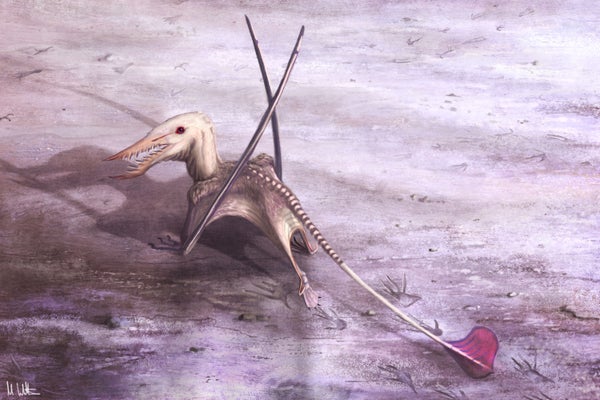Since pterosaur fossils were first discovered more than two centuries ago, scientists have lacked proof of how early members of this group of flying reptiles, from the Triassic or Jurassic periods, walked on land. But now the first known footprints of such pterosaurs, discovered in southern France, are overturning suggestions that they were sprawling or clumsy walkers that struggled when earthbound—or that they strolled on their hind legs like birds.
Even though more than 30 sites worldwide have yielded fossilized pterosaur footprints in the past few decades, all were left by pterosaurs knows as pterodactyloids—a group that was common in the Late Jurassic and throughout the Cretaceous. These later pterosaurs, such as Pteranodon and Quetzalcoatlus, had short tails and toothless jaws, and some reached the size of small airplanes.
Now French paleontologists report in Geobios that they have found trackways of non-pterodactyloid pterosaurs. This large group includes early, less specialized pterosaurs, most of which still had teeth and also long tails, such as the fish eater Rhamphorhynchus.
On supporting science journalism
If you're enjoying this article, consider supporting our award-winning journalism by subscribing. By purchasing a subscription you are helping to ensure the future of impactful stories about the discoveries and ideas shaping our world today.
“[Until now] these earlier pterosaurs have, strangely, never left any trackways,” says paleontologist Michael Habib of the University of Southern California, who was not involved in the new research. “By contrast, we have many hundreds of tracks from pterodactyloids. This has led to the prior suggestion by specialists that the earlier pterosaurs were poor at moving on the ground.”

Small pterosaurs walking adeptly on all fours left a series of trackways, such as this one, on a French beach about 150 million years ago. Credit: Jean-Michel Mazin PaleoAquitani
Some experts have even assumed these animals “were unable to walk on ground and were only climbers,” says paleontologist and lead study author Jean-Michel Mazin, who made the new find at a site called Pterosaur Beach in Crayssac, France. Researchers had long sought fossils to confirm the walking ability of these animals, he adds, “so when we discovered the first unambiguous non-pterodactyloid footprints, we were very happy.”
Excavated in digs conducted from 2000 to 2014, the alternating front and back footprints form four trackways, each just more than one meter long. The individual footprints are about three centimeters in length and were left by pterosaurs that were the size of small birds, weighed only 100 grams and walked on all fours. Paleontologists are able to estimate how big animals that left footprints were by the size and depth of the prints and the distance between them.
Although Crayssac is far inland today, 150 million years ago, in the Late Jurassic, it was a mudflat on the coast of a shallow sea. Here, animals—including dinosaurs, pterosaurs, turtles, crocodiles and crabs—left impressions in the mud and sand, which became preserved as fossils.
At first glance, the new tracks uncovered by Mazin and his co-author Joane Pouech—who, along with Mazin, is based at a museum at Pterosaur Beach—appeared to be those of pterosaurs. But when it became clear that the creatures that left them had five toes on their hind feet, the scientists realized the full significance of what they had found. Pterodactyloids had only four toes on their hind feet; non-pterodactyloids had five, Mazin says.
The trackways also revealed that these early pterosaurs’ front feet had toes that faced forward rather than being twisted out to the side, as seen in the tracks of their later relatives. “Even though they are morphologically very different from pterodactyloid tracks, these new trackways clearly showed that non-pterodactyloids were quadrupedal and good walkers,” Mazin explains.
Mazin and Pouech have “discovered and described a beautiful fossil trackway that was clearly left by one of the earlier types of pterosaurs,” Habib says, adding that the footprints show no evidence of these animals being inefficient at moving on the ground. “Their discovery counters the idea that the earlier pterosaurs were unable to walk or run effectively.”
Elizabeth Martin-Silverstone, a pterosaur expert at the University of Bristol in England, who did not take part in the work, says the fossil is the “final nail in the coffin of the idea that basal pterosaurs were awkward and clumsily walking around—and definitely of the idea that early pterosaurs might have been bipedal.” Not only did they walk on all fours, “but they moved around quickly and with style,” she adds.
Although the first known tracks from pterodactyloid pterosaurs were found in the 1950s, it has been a long and frustrating wait to find evidence of how their earlier, long-tailed relatives moved on the ground, says Mark Witton, who studies pterosaurs at the University of Portsmouth in England. He reviewed the paper describing the new research but was not involved in the study itself. “This is one of those ‘holy grail’ discoveries that we’ve long needed to answer a list of questions about early pterosaur biology,” he says. “This is a major step forward for pterosaur science.”
The finding will rapidly change views on early pterosaurs, meaning paleoartists will have to go back to the drawing board to revise existing reconstructions on these animals, Witton says. “Ideas of them being bipeds or sluggish sprawlers are out the window,” he adds.
Now that fossil hunters have a better idea of what to look for, there is a chance that more early pterosaur trackways will be found. Such discoveries might reveal further clues about gait, speed and posture. But these finds could be so rare because these animals infrequently came to the ground, meaning their footprints will continue to be prized discoveries. “They seem really less common in the track fossil record, maybe because they were walkers but also climbers or cliff dwellers” like some seabirds today, Mazin says.
Even if non-pterodactyloids walked infrequently, it does not mean they were incapable of doing so, according to Habib. “They may have preferred climbing in trees, away from predators,” he says. “Most pterosaurs of the Triassic and Jurassic were modest in size and would have had plenty of ground-based predators.”
